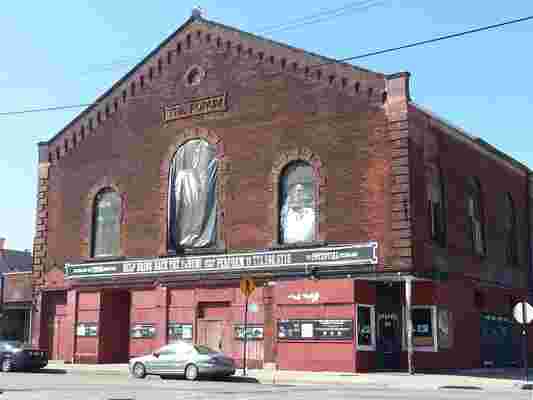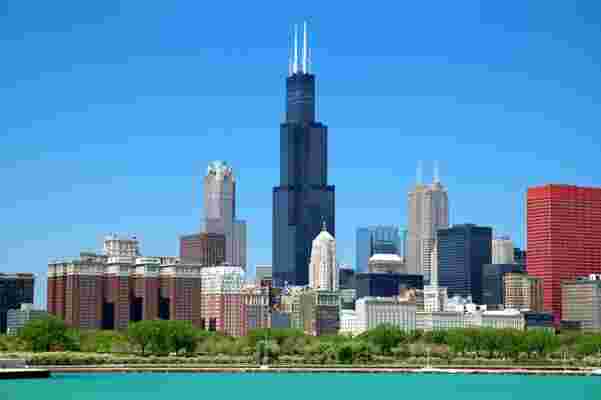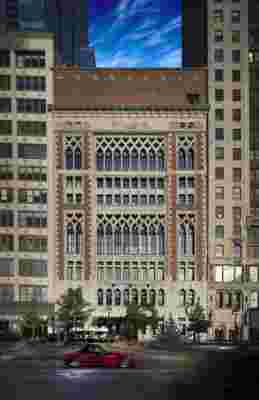Chicago has long led the way in America's history of building and design, and today is known for its wealth of architecture and innovation. On September 19, the Chicago Architecture Biennial returns with this year's theme, "…And Other Such Stories," bringing together the world's leading architects, experts, critics, and enthusiasts to celebrate the field. But when not at the biennial, visitors have a wealth of architectural marvels at their feet to explore. The Chicago Architecture Center, a nonprofit cultural organization with tours, exhibitions, programs, and events for all ages, also offers information on everything related to the city’s breathtaking architecture.
various locations openhousechicagorg

The Forum, located in Bronzeville, part of the Open House Chicago program.
“This is a choose-your-own-adventure approach, as opposed to a guided tour,” says Adam Rubin, the Chicago Architecture Center's director of interpretation. “It’s in the spirit of an open house.” CAC’s Open House Chicago program, October 19 and 20, selects various hidden architectural gems in off-the-beaten path neighborhoods around Chicago and posts the participating sites on their website starting September 10. Open House Chicago Program Manager Eric Rogers says, “It’s a massive, citywide, totally free event for people to get out and explore and visit sites that are architecturally significant, but also places that are culturally or historically significant.” The program allows locals and visitors alike to explore neighborhoods such as Bronzeville, the historic epicenter of black Chicago, and the Northwest side of Chicago focusing on Irving Park, Jefferson Park, and Portadge Park, which host a bevy of architectural marvels.
233 South Wacker Drive willistowerom

Formerly known as the Sears Tower, this modernist structure was completed in 1974 by architectural firm Skidmore, Owings & Merrill. Located in the Loop neighborhood, this was the tallest building in the world for nearly 25 years after its completion, standing at 110 stories tall. Emblematic of Chicago , the building’s black aluminum and bronze-tinted glass exterior are structurally innovative and established a precedent for tall buildings being built today.
12 South Michigan Avenue chicagoathletichotelom

Formerly a private athletic club in an 1893 Venetian Gothic landmark, this space is now a boutique hotel resting at the foot of Millennium Park. “This is a great adaptive reuse of a former private club,” says Open House Chicago Program Manager Eric Rogers. The elite club was open to men only until 2007, and officially relaunched as a 241-room hotel in 2015.
209 South LaSalle Street therookerybuildingom
Frank Lloyd Wright redesigned this 1888 building in 1907, sheltering it with a glass ceiling and maximizing the amount the building’s light and air. Considered to be one of the finest office buildings in America at this time, the structure's façade is reminiscent of late Roman, Moorish, Venetian, and medieval-European architecture. The two-story lobby and open-air public-use space is surrounded by piers, with moldings clad in white marble and gold geometric patterns, which was an element of Frank Lloyd Wright's redesign that hid the original copper-plate ironwork.
400-410 North Michigan Avenue www.architecturerg/wrigley-building
Now a Chicago landmark, The Wrigley Building was designed in 1924 by architectural firm Graham, Anderson, Probst & White with a Spanish Colonial Revival design. Located in the Near North Side neighborhood, the structure was built to be the headquarters for chewing gum magnate William Wrigley Jr. It's an icon of Chicago's main strip, the Magnificent Mile, and was inspired by the Giralda Tower cathedral in Seville, Spain.
230 North Michigan Avenue architecturerg/carbide-and-carbon-building
Formally the Carbide and Carbon Building, this Loop neighborhood site is now the luxurious St. Jane Hotel. Completed in 1929 by the firm Burnham Brothers with an Art-Deco design style, the building’s façade is composed of polished black granite, green and gold terra-cotta, and gold leaf with bronze trim. The lobby has frosted glass fixtures and Belgian marble. As a landmark, the building underwent a $106 million restoration in 2004.
50 West Washington Street thedaleycenterom
Named after Chicago’s longtime mayor, this landmark building is the city's civic center. An outstanding example of engineering, this structure is made in the International style of architecture. Across the street is the quintessential Chicago construct, the James R. Thompson Center, built by Helmut Jahn in the ’80s. Rogers says, “This is at great risk of being sold by the state and demolished. It’s an active preservation fight at the moment.” Down the block, City Hall is another architectural masterpiece worth taking the time to see.
806 Michigan Avenue architecturerg/chicago-water-tower
An 1869 Gothic Revival, the Historic Water Tower, designed by architect William W. Boyington, was the only iconic structure to remain after the Great Chicago Fire of 1871. Serving as a water receptacle for the city, Boyington designed the pumping works building and the Water Tower, using the yellow Joliet limestone for both.
300 North State Street architecturerg/marina-city
Marina City was architect Bertrand Goldberg’s urban experiment designed to draw middle-class Chicagoans back to the city after they’d fled for the suburbs. Completed in 1967 in the Near North Side neighborhood, one can see the influence of Ludwig Mies van der Rohe, Goldberg’s teacher. Goldberg’s own idea held that no right angles exist in nature, thus none will exist in architecture. Today, the mixed-use complex has residential towers, an office building, a theater, and car and boat parking.
875 North Michigan Avenue 875northmichiganavenueom
Formerly the John Hancock Center, this 1,499-foot skyscraper’s engineering allowed skyscrapers to betray their traditional rectilinear shape. Completed in 1969 with a modernist design, the building resembles a tapered rectangular tube. The space is today used as residential apartments, retail and office spaces, and a 94th floor observatory offering a breathtaking 360-degree view of the Windy City.
222 West Merchandise Mart Plaza themarom
The Merchandise Mart, also known as theMART, is an Art Deco–style building built in 1930 by architectural firm Graham, Anderson, Probst & White. The building stretches 2.5 city blocks and was one of the largest buildings in the world, serving as department store Marshall Field’s warehouse. The structure is made of limestone, terra cotta, and bronze, with recessed vertical windows, rows of decorative chevrons, and diagonal towers. The façade is now used to project permanent public digital art installations.
This striking cubist structure is unlike other buildings in Chicago—its truss system allows for pillar-less spaces within, and makes for a unique geometric façade. The Godfrey’s year-round rooftop bar and restaurant, I|O Godfrey, offers stunning and immersive views of the Tower and Marina City, and sweeping skyline views.
